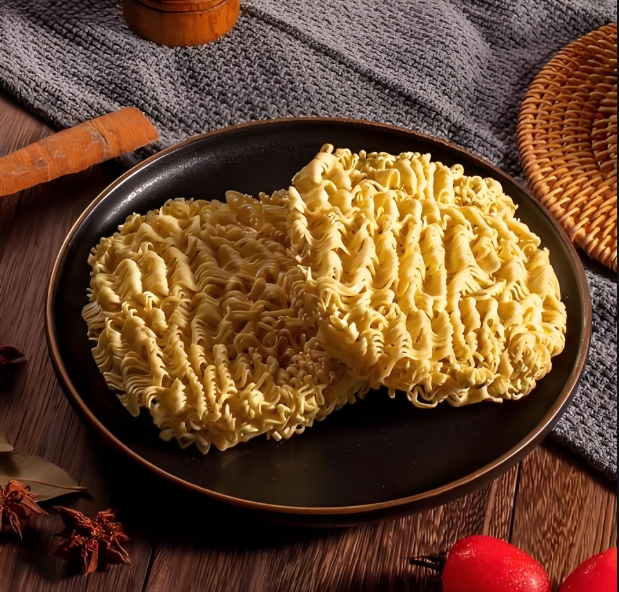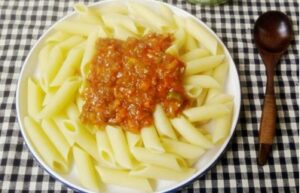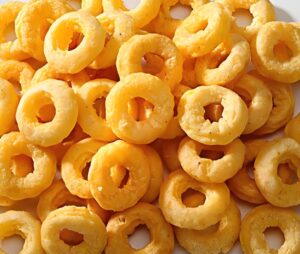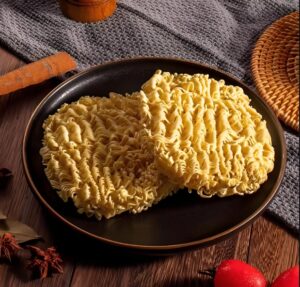How Non-Fried Instant Noodles Are Produced: A Comprehensive Guide to Manufacturing Process
Non-fried instant noodles have gained significant popularity in recent years as consumers increasingly seek healthier alternatives to traditional fried instant noodles. These products offer similar convenience with lower fat content and a nutritional profile closer to fresh noodles. This article provides a detailed examination of the complete production process for non-fried instant noodles, from raw material selection to final packaging, highlighting key technologies and quality control measures.
Instant noodle making machine
ToggleIntroduction to Non-Fried Instant Noodles
Non-fried instant noodles represent a growing segment in the convenience food market, accounting for approximately 15-20% of global instant noodle production. Unlike their fried counterparts which contain 15-20% oil content, non-fried varieties typically maintain only 4-5% fat content while offering comparable shelf stability . The fundamental difference in production lies in the drying method – where fried noodles use oil dehydration, non-fried versions employ advanced drying technologies like hot air drying, microwave drying, or combined heat-pump drying systems.
The global market for non-fried instant noodles has seen consistent 6-8% annual growth since 2015, driven by health-conscious consumers in developed markets and premiumization trends in emerging economies. Major manufacturers have invested heavily in R&D to overcome the historical challenges of non-fried noodles – slower rehydration times and less developed flavors – through innovations in ingredient technology and processing methods.
Raw Material Selection and Preparation
The foundation of quality non-fried instant noodles begins with careful selection and preparation of raw materials. Wheat flour remains the primary ingredient, typically comprising 70-85% of the formulation. The ideal flour characteristics include:
- Protein content: 10-12% for optimal gluten network formation
- Ash content: <0.5% for bright noodle color
- Starch quality: High amylose content (about 28%) for better texture
Specialty flours like oat flour (at 40% substitution rate) can be incorporated for nutritional enhancement while maintaining processing characteristics when combined with wheat flour . Other common additions include:
- Kansui solution: An alkaline salt mixture (typically sodium and potassium carbonates) that improves noodle elasticity and yellow color. The optimal pH range is 9-11 .
- Modified starches: Cross-linked waxy maize starch at 10-30% substitution improves rehydration properties and creates a more porous structure .
- Functional additives: Sodium polyphosphate (0.1-0.3%) enhances water retention and texture.
Raw materials undergo rigorous quality control including:
- Flour farinograph tests for water absorption and stability
- Starch paste viscosity measurements
- Protein content verification
- Microbial safety checks
Dough Mixing and Kneading Process
The dough preparation stage critically determines the final noodle texture and processing characteristics. Modern factories employ computer-controlled mixers that precisely regulate:
- Mixing time: 10-15 minutes
- Speed: 60-70 rpm for optimal gluten development
- Temperature: Maintained below 30°C to prevent premature fermentation
The dough formulation typically consists of:
- 100 parts wheat flour
- 28-35 parts water (adjusted based on flour absorption)
- 1-2 parts kansui solution
- 0.5-1 part salt
- 0.1-0.3 part sodium polyphosphate
Advanced operations may include pre-mixing of oil (1-3%), wheat flour, water and salt concentrate under elevated pressure (up to 2 bar) before incorporating into the main dough mixture . This pretreatment enhances ingredient interaction and improves final product uniformity.
Sheeting and Noodle Strand Formation
After resting (15-30 minutes), the dough undergoes sequential reduction through a series of precision rollers:
- Primary sheeting: Reduces dough thickness from ~50mm to ~10mm
- Intermediate rolling: 3-5 stages gradually reducing to 2-3mm
- Final calibration: Achieves uniform 0.8-1.2mm thickness
Key parameters include:
- Roller speed gradient: 0.3-0.5 m/s increasing progressively
- Roller temperature: 30-40°C to maintain dough plasticity
- Dusting flour application: Minimal to prevent sticking
The continuous sheet then passes through cutting blades that determine noodle shape:
- Straight cut: Standard 1.5-2.0mm width
- Wavy cut: Special corrugated rollers create textured surface
- Fine noodles: 0.8-1.2mm for quicker rehydration
Steaming and Partial Gelatinization
Steam treatment serves multiple critical functions in non-fried noodle production:
- Starch gelatinization: Typically reaches 85-95% completion
- Protein denaturation: Sets the noodle structure
- Enzyme inactivation: Extends shelf life
- Microbial reduction: Important for food safety
Modern steam tunnels feature:
- Temperature: 100-105°C
- Residence time: 2-4 minutes
- Steam saturation: 90-95% relative humidity
- Zone control: Progressive heat application
Advanced monitoring systems track:
- Real-time gelatinization degree via NIR sensors
- Moisture uptake (typically 5-8% increase)
- Temperature uniformity across noodle strands
Specialized Drying Technologies
The drying process represents the most distinctive difference from fried instant noodles, requiring precise control to achieve both shelf stability and good rehydration properties. Common approaches include:
1. Hot Air Drying
- Temperature: 70-80°C
- Time: 35-40 minutes
- Air velocity: 1.5-2.0 m/s
- Final moisture: <14.5%
2. Heat-Pump Assisted Drying
- Combines 75°C hot air with 87 minutes pressure differential treatment
- Achieves 6.75% moisture content
- Reduces rehydration time to under 5 minutes
3. Multi-Stage Hybrid Drying
- Initial microwave drying (2-3 minutes)
- Intermediate hot air (60°C, 15 minutes)
- Final ambient air conditioning
Microstructural analysis shows these methods create a porous but coherent starch-protein matrix, differing from the more open structure of fried noodles but superior to simple air-dried products .
Quality Enhancement Technologies
Microbial Fermentation
Innovative producers employ controlled fermentation to improve quality:
- Yeast fermentation: Enhances rehydration and texture
- Lactic acid bacteria: Improves flavor profile
- Optimal combination: 1.5% yeast + 0.075% Lactobacillus + 0.075% Streptococcus
- Benefits:
- Reduces optimal rehydration time to 4 minutes
- Creates more uniform porous structure
- Develops pleasant fermented aroma
Modified Atmosphere Packaging
- Nitrogen flushing (O₂ < 1%)
- Oxygen scavengers
- High-barrier multilayer films
- Extends shelf life to 12+ months
Quality Control and Testing
Rigorous quality assurance protocols ensure consistent product performance:
- Rehydration Testing
- Time measurement (target: 3-5 minutes)
- Weight gain ratio (≥3.5 times)
- Texture evaluation (firmness, elasticity)
- Physical Properties
- Color measurement (L, a, b* values)
- Moisture content (<10%)
- Oil content (<5%)
- Microbiological Standards
- Total plate count <10,000 CFU/g
- Coliforms <100 CFU/g
- Pathogens: negative
- Sensory Evaluation
- Trained panels assess:
- Flavor
- Mouthfeel
- Aftertaste
- Overall acceptability
Comparison with Fried Instant Noodles
While sharing similar convenience, key differences exist:
| Parameter | Non-Fried | Fried |
|---|---|---|
| Moisture Content | 10-14.5% | <10% |
| Oil Content | 4-5% | 15-20% |
| Production Time | Longer drying | Quick frying |
| Texture | Denser, chewier | Crispier, lighter |
| Nutrition | Lower fat, closer to fresh noodles | Higher energy density |
| Flavor Carrying | Requires enhanced seasoning | Oil carries flavors well |
Future Trends and Innovations
The non-fried instant noodle sector continues to evolve with several promising developments:
- Ingredient Innovations
- Pulse flour incorporation (pea, chickpea)
- High-fiber additions (psyllium, beta-glucan)
- Protein fortification (whey, soy isolates)
- Process Advancements
- Infrared-assisted drying
- High-humidity thermal treatment
- Extrusion-based forming
- Functional Noodles
- Probiotic-enriched
- Low-glycemic index formulations
- Vitamin/mineral fortified
- Sustainability Focus
- Energy-efficient drying systems
- Water recycling in processing
- Biodegradable packaging
Conclusion
Non-fried instant noodle production represents a sophisticated interplay of food science and engineering, balancing nutritional quality with convenience attributes. Through controlled processing steps from specialized dough preparation to advanced drying technologies, manufacturers can create products with:
- Healthier lipid profiles
- Cleaner ingredient labels
- Satisfactory sensory qualities
- Extended shelf stability
As consumer demand for healthier convenience foods grows, continued innovation in non-fried noodle technology will likely expand market share and product variety. The future points toward more sustainable production methods, cleaner formulations, and enhanced functional benefits while maintaining the essential convenience that defines instant noodles.
Would you like more detailed information about any specific aspect of non-fried instant noodle production, such as particular drying technologies or quality testing methods?









